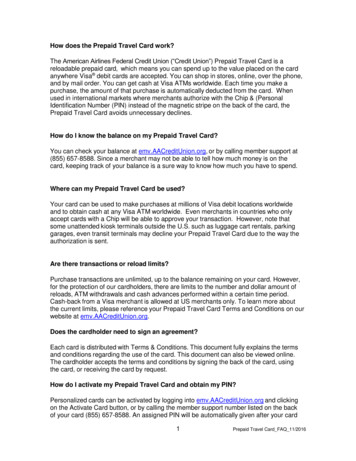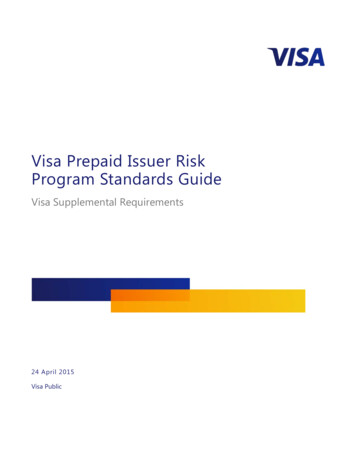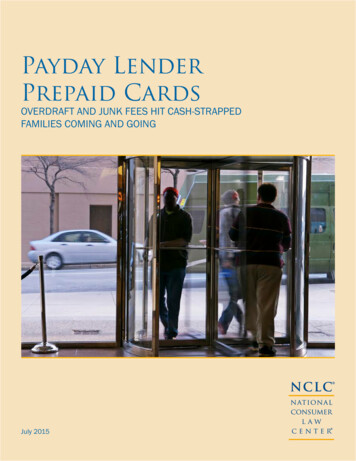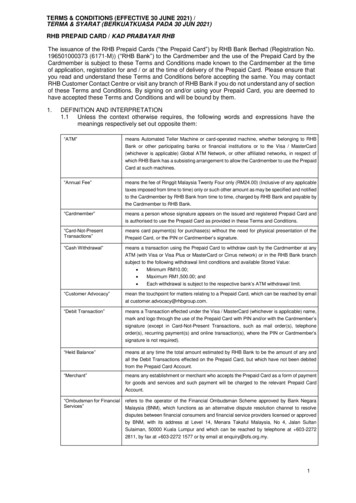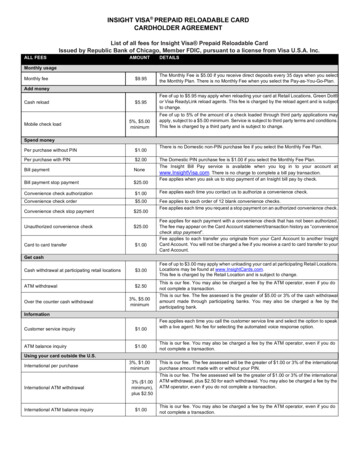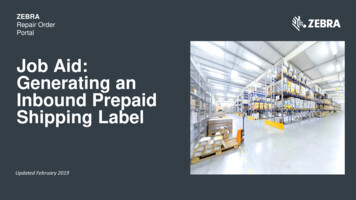
Transcription
TRANSPORTATION PERSPECTIVES: Convert from Prepaid to Collect for Greater Control, Visibility and Cost SavingsDoes Prepaid-To-CollectConversion Make Sense?Guidelines for making the right freight paymentdecisions for your businessBecause suppliers are typically responsible for gettingproducts to a customer’s distribution center (DC),buyers don’t possess the same kinds of controls over theirinbound shipments as they do for outbound loads. Manycompanies remain unaware of just how much their inboundfreight costs them because these charges are “buried” inthe prices they pay for the goods.In fact, freight allocations average between 4 to 7% of overall product cost.That means it costs at least 40 to ship an item valued at 1,000. But, what ifyou could save up to 25% of that cost? Multiplied by millions, even thousands,of products, the potential cost savings is substantial.As important as reducing costs, buyers are finding that gaining more controland visibility over inbound shipments is important because their brandreputation hinges on timely availability of quality products for their end users.Manhattan Associates collaborated with transportation customers andsuppliers to develop solutions and industry best practices targeted atgiving today’s companies more control over and visibility into their inboundshipments by converting their freight from prepaid to collect—ultimatelyreducing transportation costs along the way.Prepaid-to-Collect—What’s the Difference?As important as reducingcosts, buyers are findingthat gaining more controland visibility over inboundshipments is importantbecause their brandreputation hinges on timelyavailability of qualityproducts for their end users.1With prepaid shipments, the supplier or shipper owns the responsibility for thefreight payment and is ultimately charged with delivering the goods from thefactory to a supplier-managed DC and on to the customer’s DC. In the collectworld, you, the buyer, hold the freight responsibility and manage shipments toeither the supplier’s DC or direct from the factory to your warehouse facility.When shipping choices are left up to suppliers, companies have little to nocontrol over inbound flow and freight charges related to goods and materials,which can eventually lead to issues downstream such as inventory shortages,late deliveries, dissatisfied customers and higher costs for your company. Mostimportantly, if a product is late or you run out of inventory, your customerswon’t blame your suppliers—they’ll blame you.Does Prepaid-To-Collect Conversion Make Sense?
It is imperative that youcompare your shipping ratesand carrier service levelsregularly. An analysis oftransportation as part of costof goods indicates wherethere are opportunities forimprovement in efficiency,cost savings and servicelevels for inbound freight.Suppliers often bring in extra profits for themselves by building and bundlingexcess freight and handling charges into their final invoices—making thetrue costs harder to detect and control. And, when lower freight rates anddiscounts are negotiated, the suppliers, which pay the freight bills, become theprimary beneficiaries. Very rarely do they pass the savings on to you.Shipping freight prepaid, although a universal business practice, is often saidto encourage poor performance and even possible abuse within the system.Poor carrier performance, in the form of late deliveries and damaged freight,falls squarely on the customer. As the supplier reaps the benefit of prepaidfreight on the front end, the customer suffers through unnecessary costs andpenalties on the back end.PrepaidSupplier ManagedFactorySupplier's DCCompany ManagedCompany DCStoreCollectSupplier ManagedFactorySupplier's DCCompany ManagedCompany DCStoreCollectCompany ManagedFactoryCompany DCStoreKnow When to Say WhenMost companies only evaluate their carrier or logistics networks every year ortwo, if at all. As mentioned previously, there are a number of organizations thatdon’t know their actual transportation costs.It is imperative that you compare your shipping rates and carrier service levelsregularly. An analysis of transportation as part of cost of goods indicates wherethere are opportunities for improvement in efficiency, cost savings and servicelevels for inbound freight.2Does Prepaid-To-Collect Conversion Make Sense?
Whether you’re regularly reviewing your transportation costs or not, the followingred flags may indicate your company is ready for a prepaid-to-collect conversion:A rise in transportation-related chargesIn today’s economy, everyone is looking at ways to cut costs. And, one way,obviously, is through transportation. Effectively your suppliers are makingmoney off of the freight. An analysis of the difference between what theypay to their carriers versus what is billed back to you can help determinewhich supplier lanes make sense to convert in order to drive down costs. Forexample, if there is a final invoice for 3,000, of that, maybe 1,000 is related totransportation. If you can go to the open market yourself and get that for 800,you’ve lowered the costs overall for your company.Companies with collectfreight can better managetheir loads and look foropportunities to combineLTL shipments with otherfreight to build up multistoptruckloads. Cross-supply orload consolidation drivescost efficiencies.3Consistently late deliveries or damaged freightService issues, whether they involve transporting freight late, showing up atthe loading dock unexpectedly, or consistently delivering damaged goods,are disruptive to operations and affect customer satisfaction in the end—noneof which companies can afford in today’s marketplace. By converting fromprepaid to collect, you have the opportunity to better manage inbound freightand maintain a current carrier base with high-performance standards. With astrong core carrier program, lead time from the supplier to the shipper’s DCcan be reduced, and product can actually be picked up and shipped theday it’s ready. This facilitates more on-time deliveries and reduces days ofinventory supply. You can establish your own contract terms and then leverageyour carrier base to improve service for the inbound product coming into yourDC. It could be that you require “x” percent of the shipment damage free.Maybe you need to drop so many trailers in your lot so they’re available forloading/unloading at your convenience.Increases in less-than-truckload (LTL) shipmentsLoad consolidation is another area where companies can realize significanttransportation cost reductions. Companies with collect freight can bettermanage their loads and look for opportunities to combine LTL shipmentswith other freight to build up multistop truckloads. Cross-supply or loadconsolidation drives cost efficiencies. Instead of paying LTL as three separateshipments, you can combine them in multistop truckloads and improve serviceand drive down costs. For example, a grocer purchases from three differentvendors and the respective shipments amount to 10,000 pounds each—notenough to fill a full truckload. Those three 10,000-pound shipments deliveredindependently are more expensive than one truck making three stops at thosevendors and transporting it as a multistop shipment with 30,000 pounds. Notonly can that grocer take advantage of better freight rates, but by reducing thenumber of carriers delivering to the warehouse, it ultimately translates into theneed for less labor to unload trucks.Does Prepaid-To-Collect Conversion Make Sense?
Automation Puts Conversion in the Fast LaneSelecting the right carriers can make a significant difference in profitabilityand customer satisfaction, not to mention your peace of mind. But the bestcarrier for each case is not always the low-cost carrier. How can you sort outwhich combination of carriers will best meet your complex transportationrequirements?Without automated support, evaluating and selecting carriers is a timeand resource-intensive process. The most powerful technology tools notonly have the ability to assist you in going out to market and procuring thecarriers needed for the converted freight, but they also have the features tointelligently plan and execute those converted shipments.The following table depicts the activities involved in a prepaid-to-collectconversion as well as ones you should ensure any technology you selectcan handle:Prepaid-to-Collect ProcessThe most powerfultechnology tools notonly have the ability to assistyou in going out to marketand procuring the carriersneeded for the convertedfreight, but they also havethe features to intelligentlyplan and execute thoseconverted shipments.Bid Preparation Shipments – Collect, cleanse, and analyze shipment history Suppliers – Identify and request customer pickup allowances Carriers – Identify and develop contract requirements Prepare Bid Package – Identify lanes and volume to bidBid Execution Conduct carrier conference and carrier training Distribute the bid package Support the carriers while the bid is openScenario Management Analyze carrier responses Run scenarios to determine optimal carrier assignment Award lanesTransition Management Create files / reports to load lanes, carrier capacity and rates Transition suppliers and carriers by lane Monitor compliance / execution4Does Prepaid-To-Collect Conversion Make Sense?
Leading U.S. Grocer Rings Up Savings withPrepaid-to-Collect StrategyA 15-billion grocery retailer recently went through a prepaid-to-collectconversion. The retailer evaluated its at-the-time 20 million transportationspend across 98 lanes with the goals of converting from prepaid to collectand reducing the number of carriers. As a result, the company realized thefollowing results: By automating the process, the retailer completed the bidding in threemonths (If conducted manually, then it would have taken 5-6 months) O f the 64 new transportation providers invited to bid, 30 lanes weresuccessfully awarded; and To date, the grocer has secured 3.6 million in savings.This grocery retailer, like many other companies, understands it must mitigatethe forces driving transportation costs now to ensure future success. Althoughinbound shipments may have been taken for granted in the past, you shouldnot miss this favorable opportunity to determine freight terms and shippingarrangements that are best for your company. Converting more of yourinbound freight from prepaid to collect gives you more control, visibility, costefficiencies and reliability that you’ll need for the future.For more information about how Manhattan’s Transportation ManagementSolutions can help you gain greater control, visibility and cost efficiencies,contact us at info@manh.com or 1 (877) 596-9208.About Manhattan Associates, Inc.Manhattan Associates, Inc. brings companies closer to their customers. We design, build and deliver market-leading Supply Chain Commercesolutions that drive top-line growth by converging front-end sales with back-end supply chain execution and efficiency. Our software, platformtechnology and unmatched experience help our customers around the world adapt to the challenges of the omni-channel marketplace. For moreinformation, please visit www.manh.com Manhattan Associates. All Rights Reserved.manh.com manh.com.mx manh.co.uk manh.com.fr manh.nl manh.com.au manh.cn manh.co.jp5Does Prepaid-To-Collect Conversion Make Sense?
freight payment and is ultimately charged with delivering the goods from the factory to a supplier-managed DC and on to the customer's DC. In the collect world, you, the buyer, hold the freight responsibility and manage shipments to either the supplier's DC or direct from the factory to your warehouse facility.
